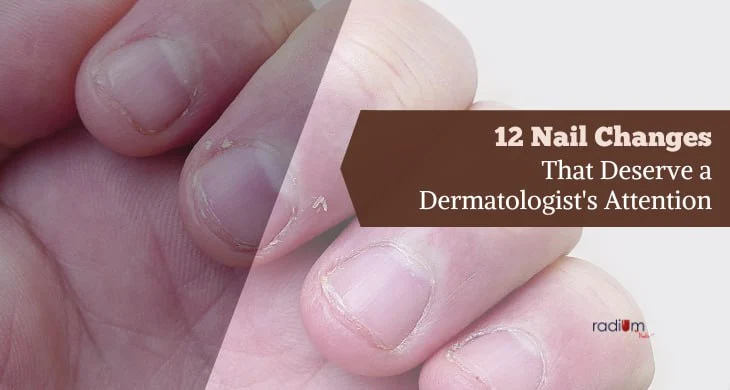Have you observed any alterations in your nails recently? While changes in color, texture or shape might be harmless they can also signify underlying health issues. If you notice any of the following changes seeking advice from a board-certified dermatologist is crucial:
Medical Term: Acral Lentiginous Melanoma.
Dark Streak Alert: If you discern a novel or transforming dark streak, a crucial step is consulting a dermatologist promptly for a comprehensive skin cancer evaluation. This dark streak may be the stealthy presence of melanoma, the most severe form of skin cancer.
While not every dark streak spells melanoma, seeking the expertise of a dermatologist is a prudent measure. Timely detection and intervention can potentially render this the sole treatment required.
Allowing this condition to advance unhindered heightens the complexity of treatment. Hence, swift action and professional evaluation are paramount to safeguarding your skin health. Stay vigilant, prioritize dermatological assessments, and confront dark streaks with proactive care.
Medical Term: Onycholysis
Nail Lifting Woes
When a nail begins to detach, revealing white discoloration, it’s a signal. Causes include:
- Fungal infection
- Psoriasis
- Aggressive manicure injury
- Sharp object damage while cleaning nails
For any lifting nail, a dermatologist examination is crucial. Treatment may be necessary for infections, and a dermatologist can provide guidance for a healthy regrowth.
Medical Term: Paronychia
Inflamed Nail Woes
Spotting redness and swelling around a nail hints at a potential infection. Early diagnosis allows for treatment through soaks and antibiotics. For cases with open sores, more extensive care becomes necessary.
Medical Term: Paronychia
Unusual Hue Alert
A greenish-black color in your nails could signal a bacterial nail infection. Without intervention these infections can escalate causing pain and tenderness. Timely treatment is crucial to alleviate discomfort and clear the infection.
Medical Term: Pitting
Indents Unveiling Secrets
Discovering small dents in your nails, resembling marks from an icepick, might indicate an underlying systemic condition. Conditions like psoriasis, atopic dermatitis or alopecia areata could be at play. Seeking evaluation from a board-certified dermatologist is vital for a precise diagnosis. Dermatologists specialize in diagnosing and treating these conditions offering relief and preventing further progression.
Medical Term: Yellow Nail Syndrome
Golden Hues with Hidden Clues
While red nail polish or smoking may tint your nails yellow, persistent discoloration, thickening, and stunted growth could signal an internal issue. Yellow nails might indicate conditions such as lung disease, rheumatoid arthritis, or a severe nail infection, necessitating prompt attention and appropriate treatment
Medical Term: Beau Lines
Nature’s Timeline: Understanding Nail Grooves
While longitudinal lines on nails are usually harmless, deep horizontal grooves signal a pause or cessation in nail growth. Known as onychomadesis, this condition can result from various causes, such as fever, injury, chemotherapy, or severe stress. If your nails exhibit these gaps without a clear cause, seeking advice from a dermatologist or primary care doctor is essential. Identifying and addressing the underlying trigger often restores normal nail growth, allowing your nails to resume their natural course.
Medical Term: Onychogryphosis
Rams Horn Nails: Nature or Nurture?
The phenomenon of Rams Horn nails, characterized by thickening and overgrowth, can be hereditary or indicate an underlying condition. While some inherit this trait others may develop it due to diseases like psoriasis, ichthyosis or circulation issue. Managing and treating such nails necessitates expertise from a podiatrist or dermatologist. Understanding the root cause ensures appropriate care for this unique nail condition.
Medical Term: Koilonychia
Spoon-shaped Nails: A Clue to Your Health
Thin fingernails with a distinctive spoon shape signal potential iron deficiency. Multiple factors such as inadequate nutrition, stomach or intestinal issue, gluten sensitivity (celiac disease) or high altitude living can contribute to this condition. Seeking a proper diagnosis and treatment is essential for improved well-being.
Medical Term: Onychotillomania
Washboard Nails: Unraveling a Nail-Picking Habit
Grooves and ridges in the center of your thumbnail, resembling a washboard, may indicate a habit of picking at or pushing back cuticles. Often unnoticed, this behavior can impact nail health. Consulting a dermatologist offers guidance in breaking this habit, fostering the growth of healthy and beautiful nails.
Medical Term: Clubbing
Curved Nails: Decoding Changes in Nail Shape
The subtle progression of nail curving, often unnoticed, may lead to swelling fingertips and a spongy feel upon pressing. If you observe such changes, consulting a board-certified dermatologist becomes essential. While curved nails can be a benign familial trait, they may also signal underlying conditions in the lungs, heart, or liver, emphasizing the need for professional evaluation.
Changes in Nail Color
Nail color alterations may signify underlying health conditions. A spectrum of colors, such as blue indicating low oxygen, white linked to liver disease or diabetes, and pale signaling anemia, can offer valuable insights. Half-pink, half-white nails may suggest kidney issues, yellow nails might point to lung disease or infection, and dusky red half-moons could be associated with lupus, heart disease, alopecia areata, arthritis, or dermatomyositis. Blue half-moons could be indicative of poisoning. While not every change means disease, attentive observation allows for potential health awareness.
Conclusion
In conclusion, while nail changes may not always be indicative of disease, seeking guidance from a board-certified dermatologist is crucial for accurate diagnosis and appropriate care. These specialists, with expertise in skin, hair, and nail conditions, offer valuable insights into distinguishing harmless variations from those necessitating medical attention. Prioritizing your nail health through professional consultation ensures informed decisions and proactive measures to maintain overall well-being.

